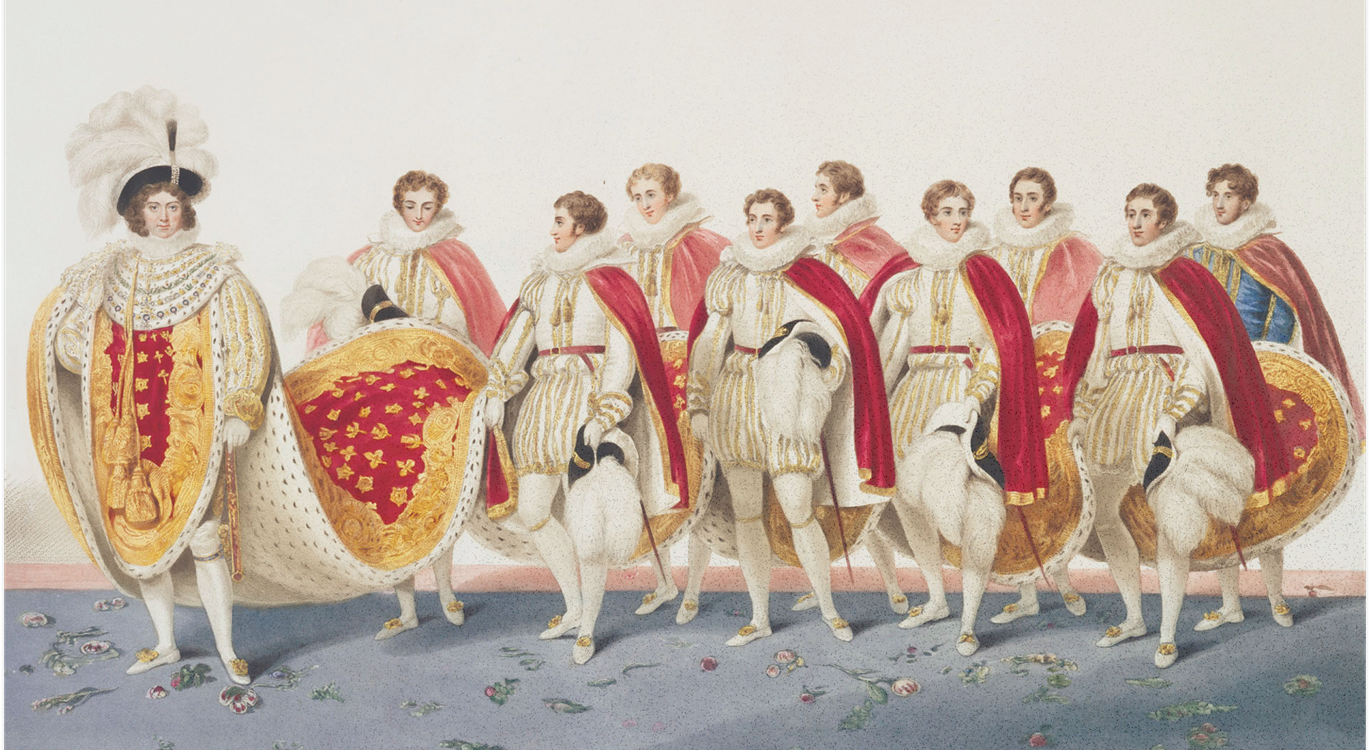The coronation of King Charles III will likely follow most of the procedures set out in this ancient 14th Century manuscript, which contains the record of the coronation of King Richard II in 1377 and also that of his first wife, Queen Anne of Bohemia, in 1382. Although each coronation is unique, the basic order has remained unchanged for centuries.
Through the six stages of the coronation the King will wear different Royal Robes. The order in which these robes are to be worn is set out in the Liber Regalis and, like so much that happens during a coronation, has symbolic significance.
As King Charles makes his way into Westminster Abbey, he will be wearing the Robe of State, also referred to as the Parliament Robe due to its role in each State Opening of Parliament.
During the part of the ceremony known as “the anointing”, he will have all symbols of state removed and will wear the Colobium Sindonis (Latin for “Shroud Tunic”). This is a symbol of the monarch standing before God stripped of all worldly status and possessions.
Worn over the Colobium Sindonis during the investiture is the Supertunica, inspired by the full dress consul uniform of the Byzantine Empire. This is a flamboyant robe decorated with the national symbols of the home nations and fastened by a golden buckle adorned with roses, thistles and shamrocks.
When the crown is placed on his head, King Charles will also be wearing another robe on top of the Supertunica. The Robe Royal (Pallium Regale) has imperial eagles crafted in silver thread decorating the corners of this four-square mantel. The symbolism of this robe is more spiritual than temporal.
At the end of the ceremony, the Imperial Robe, also known as the Robe of Estate, is worn. This is the robe that will feature in the coronation portraits and is a purple silk and velvet robe, embellished with embroidered ears of wheat, displayed down both sides of the train, representing peace and plenty, with a three-dimensional embroidered golden crown.
Each of these robes are symbolic and essentially aspirational. They are a display of the historical expectations which lie heavily upon a newly crowned monarch. There is much for King Charles to live up to as he dons robe after robe on his coronation day.
It should be no surprise that a ceremony with its origins in medieval times, when the Church had control over these matters, should be drawn from parts of the Bible.
In the Old Testament, instructions for Israel’s annual Day of Atonement (Leviticus chapter 16) prescribed the garments that the High Priest would wear as he fulfilled his duties on that important day. He had “garments of beauty and glory” which dignified his person, covering him with beauty and glory which in himself he did not possess. Prior to his entrance into the holiest place within the tabernacle, he had to divest himself of these garments and “put the holy linen tunic and the linen trousers on his body; he shall be girded with a linen sash, and with the linen turban he shall be attired. These are holy garments” (Leviticus 16:4).
The high priest’s garments are a beautiful picture of the essential character of the Lord Jesus Christ. He does not need garments to clothe Him with glory.
Moses had to be sheltered in the cleft of a rock as He was granted a glimpse of the glory of the Lord. Isaiah cried out when he saw the Lord in a vison:
“Woe is me, for I am undone!
Because I am a man of unclean lips,
And I dwell in the midst of a people of unclean lips;
For my eyes have seen the King,
The Lord of hosts” (Isaiah 6:5).
When the Lord took Peter, James and John up a mountain and was transfigured before them, “His face shone like the sun, and His clothes became as white as the light” (Matthew 17:2). His glory and beauty radiated from Him as His essential character was displayed.
Likewise, when He set aside His glory and came down in humility and servanthood to live among men and give Himself as a sacrifice for sin, no garments of humility were required. He came to Bethlehem, not Jerusalem. He was a child refugee in Egypt, not a Prince like Moses. He was a carpenter in Nazareth, not an Emperor in Rome. He had twelve poor disciples, not a retinue of wealthy retainers. He owned no property and when He died His possessions amounted to the clothes on His back. The Apostle Paul chronicled His journey from eternity into time and back again:
“who, being in the form of God, did not consider it robbery to be equal with God, but made Himself of no reputation, taking the form of a bondservant, and coming in the likeness of men.
And being found in appearance as a man, He humbled Himself and became obedient to the point of death, even the death of the cross.
Therefore God also has highly exalted Him and given Him the name which is above every name, that at the name of Jesus every knee should bow, of those in heaven, and of those on earth, and of those under the earth, and that every tongue should confess that Jesus Christ is Lord, to the glory of God the Father” (Philippians 2:6-11).
The high priest’s garments of beauty and glory, as well as the holy garments, pointed forward to a Man who never needed to aspire to those great attributes, but possessed them in Himself and displayed them throughout His life.
One of the joys of becoming a Christian is to increasingly appreciate the beauty, glory and holiness of the Lord Jesus, until the day when we see Him face to face. The coronation of King Charles will no doubt be a dazzling display of regal splendour, pomp and glory but it cannot be compared to the glory and majesty of the Lord Jesus and the wonder we will experience when we finally see Him.
“What a day that will be,
When my Jesus I shall see,
And I look upon His face,
The One who saved me by His grace . . .”



